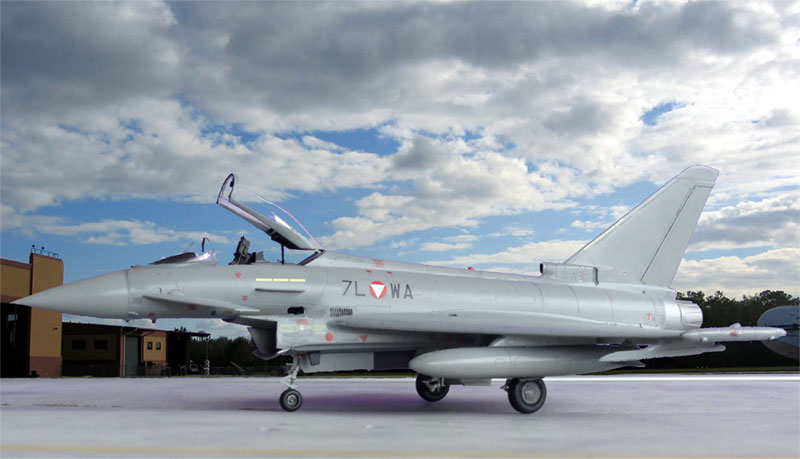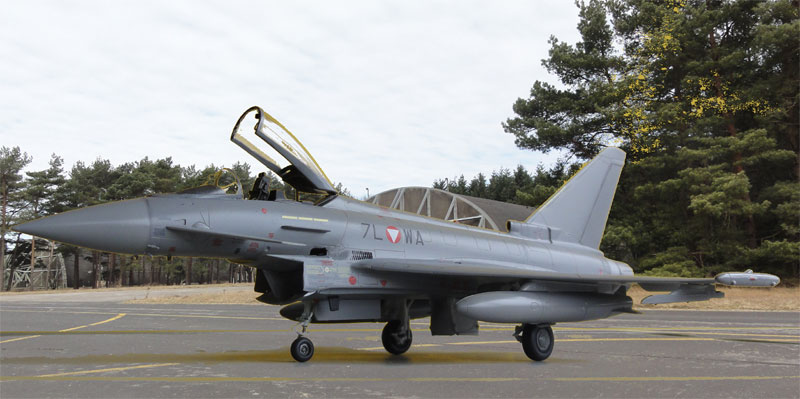[ Page 1 ]
Eurofighter Typhoon in 1/72 scale: kit review & modelling report
page 2
The Eurofighter EF2000, named the Typhoon by the RAF, is an advanced multi-role combat aircraft with an impressive manoeuvrability for the air superiority role. Equipped with the latest generation of guided missiles, the Eurofighter can deploy several advanced weapons. It has a top speed of Mach 2.0+ with 2 Eurojet EJ200 engines with afterburner (90 kN each). Deliveries began at the end of 2003 and hundreds of aircraft are in service with the German Luftwaffe, British RAF, Italia, Spain, Saudi Arabia and ... Austria.
The Revell kit 04317 dates from 2007 and is very good.
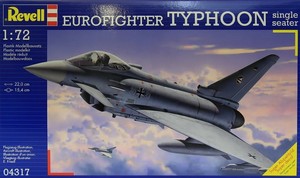
It has fine engraved panellines and captures the complex looks of the real Typhoon very well. It also has quite some stores in the kit like two external wing tanks, 4 Meteor missiles, 4 AMRAAM missiles, 2 Sidewinder missiles, 2 IRIS-T missiles, 2 Taurus Missiles and 2 Storm Shadow missiles.
There are a couple of hundred parts,
including many for the stores.
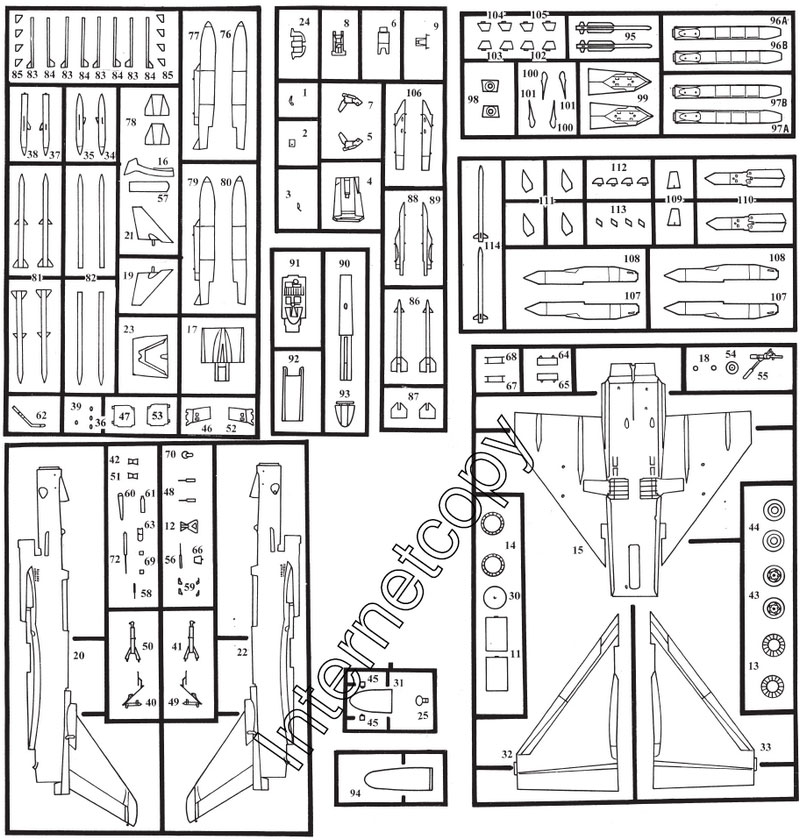
Decals are very impressive and for no less
than 6 schemes! A German air force, RAF, Spanish air force, Italian and
Austrian air force Typhoon:
- EF2000, Luftwaffe Jagdgeschwader
73 Steinhoff , Laage, 2007
- EF2000, Luftwaffe Jagdgeschwader
74, Neuburg, 2007
- EF2000, Austrian Air Force, 2007
- Typhoon F2, Royal Air Force Coningsby,
UK, 2005/2007
- Typhoon, 4░ Stormo, 9░
Gruppo, Italian Air Force, Grosseto, 2006
- EADS-CASA C.16 Typhoon Grupo 11,
113 Escuadrˇn, Spanish Air Force, Morˇn Air Base, 2006
![]()
Construction of the kit is rather straight forward.
The Martin Baker Mk.16A seat is well detailed with several parts. Some harness straps from tape were only added.
In STEP 4 the decals are wrongly numbered.
Decalnumber is not 253 but 257 and 255 is 259, 259 should be 260, 257 should
be 261. Decal 258 is not shown. The result is a nice instruments and cockpit
look with the tub. Seat will be fitted at the last stage.
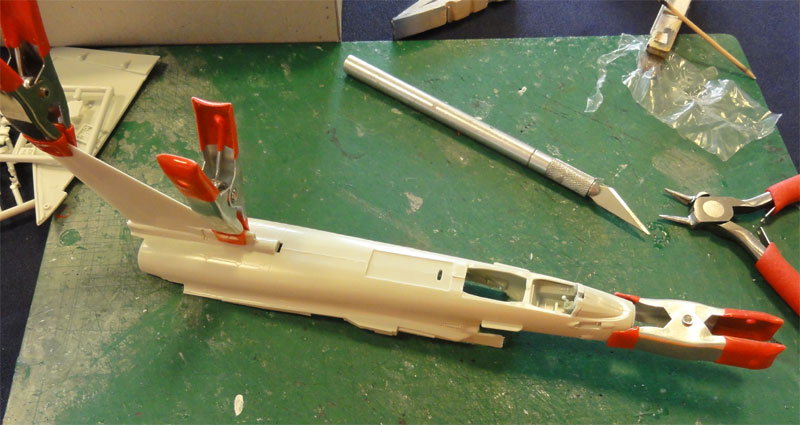
In the instructions sheet STEP 6,
the canards were not fitted to prevent damage. Although there is an intake
trunk to be painted white, the engine fan faces can be seen but are missing.
A couple were retrieved from the spares box and fitted inside. There is
a choice for open or closed afterburner cans and the exhaust pipes are
deep. Well done.
Wing fitting in STEP 10 requires carefull
alignment and some putty and sanding. The long junction needs some some
as well as getting the intake area smooth. But nothing very difficult though.


The fit of the upper airbrake fairing
#90 in STEP 14 and the airbrake itself (part #92 and seen in STEP 25) requires
filler and sanding. Better to pick the closed airbrake option and sand
everything smooth. The airbrake outlines were than inscribed with an OLFA
p-cutter.
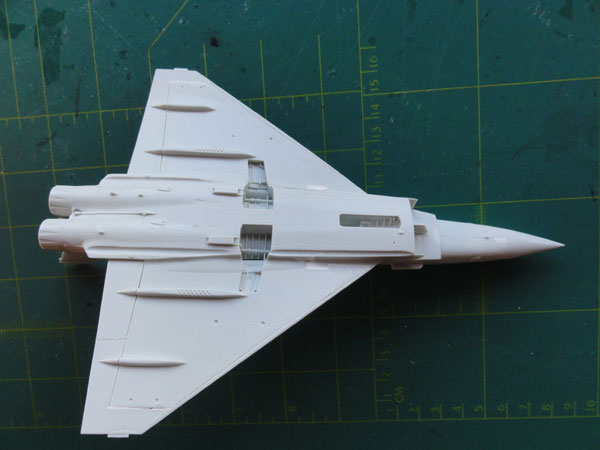
Some extra filling and sanding was
needed...


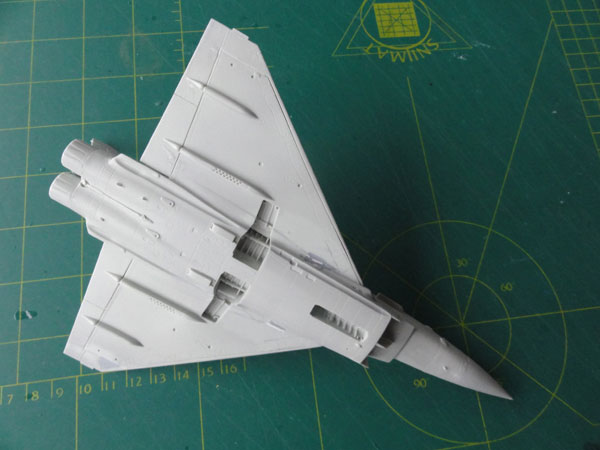
The undercarriage was fitted after painting the main model. It is well detailed. So skip STEPs 16-20 for now. In STEP 21 the nose sensor fairing is not applicable for all versions.
The canopy will be fitted later and
can be set open, Revell suggests how this can be done. I settled with some
metal pins for strength at the back op the canopy.
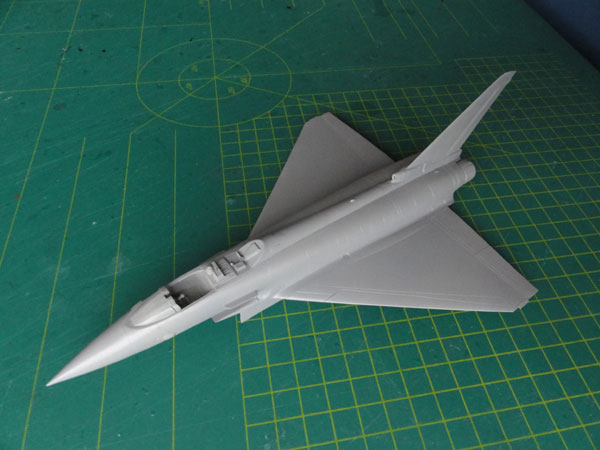
The overall model being now assembled
shows a very nice model of the Eurofighter. Now it was time to assemble
the desired stores which are good. Depending on the scheme picked, select
which ones are desired.
First a base coat of grey was airbrushed
with the Harder Steenbeck airbrush
to check for any flaws. Corrrections with minor amounts of putty were done.


It was decided to pick the AUSTRIA
air force scheme for the EF2000, of aircraft code 7L-WA (cn 133/AS001).
For the Austrian Eurofighter the
grey coat selected with GUNZE SANGYO 337 acrylic, which is FS35237.
NOTE: I later found it should be FS36231!
Some areas like the radar nose, leading edges and on the intake have a lighter "flint grey" or Barley shade. I used there GUNZE 306. This was masked off with low tack masking tape and airbrushed. Undercarriage is very light grey.
Than, the Eurofighter model got a gloss coat to allow decal application preventing "silvering". (That is to prevent tiny air bubbles that settle below the decal and look bad on a model) using this method.... And with the airbrush, a gloss coat of Johnson Future thinned with 40% "ketonatus" alkohol was thus first airbrushed.
Time for the decals, which have lots
of stencilling, very nice, but it take quite some time to apply to the
model. About 3 hours it took.

Next after drying time, the undercarriage
was fitted as seen in STEPS 16-20. It needs some work and the gears were
painted and very light grey. Also two fuel tanks were added with their
pylons.
A very light wash was applied using PROMODELLER with a tiny airbrush, such as the fuselage grills near the wing junction, the APU exhaust midwing-junction and the flaps and slat.
Anti-collision lights were tipped with paint and Microscale Kristal Kleer.
The model now got a protective coat with the airbrush also making it a bit duller with a semi-gloss coat of Johnson Future, thinned with 40% Alkohol with about 10% Tamiya X21 flatbase matting agent.
Now the other fragile parts can be
fitted, like the small pitot tubes and sensors as seen in STEP 26. The
canopy frame was painted also on the inside. 3 small mirrors and 2 handles
were fitted on the inside frame from scrap plastic. Canards were set and
seat was installed followed by the canopy. That completed the model.
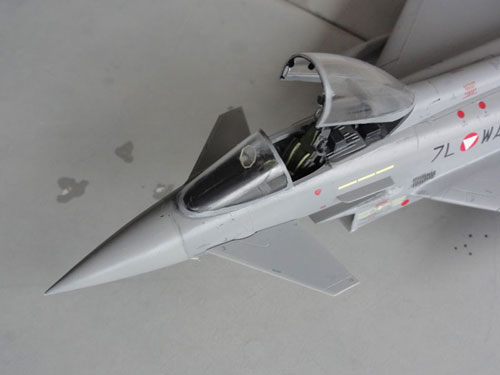
AUSTRIA
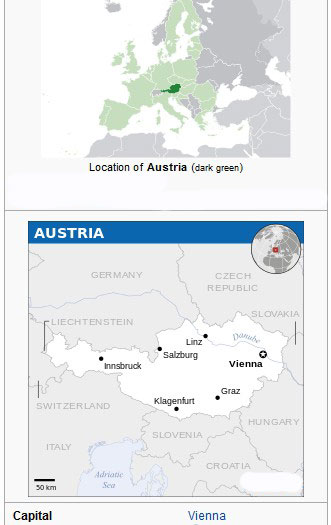 .
. ..
.. ....
....[ area: 84,000 sq.km | capital: Wien (Vienna) | population: 8,9 million | GDP 45,000 Euro per capita nominal ]
Austria with the capital Vienna on the Danube lies in Central Europe. In the 19th century there was the Austro-Hungarian monarchy. During the First World War it supported Germany. There was a local aircraft industry. Ph÷nix D.I and D.II built scout biplanes and OEFFAG German Albatross fighters. Lohner built flying boats that were later built by the Italian Macchi under license. After the end of World War I, the empire was split under Allied pressure into Austria and Hungary. Austrian military aviation began in the interbellum secretly as a paramilitary organization from 1927. After the First World War, it was forbidden in Allied treaties to have military aircraft. The "Heimwehr" started in 1933 with aircraft such as the Ansaldo A.120 and Fiat CR.20 biplanes and the local Pintsch factory built Raab Schwalbes. After pressure from Hitler Germany in 1938 the "Anschluss" came with the German Empire. German and Italian aircraft were flown such as Breda Ba.28 and Focke Wulf Fw.44 and Fw.58 bombers. Fighters were Gotha Go.145 and Fiat CR.30 and CR.32.
After World War II, the Allies enforced Austria to remain neutral. The "Austrian Air Force", as part of the Austrian Armed Forces "Bundesheer", was founded in May 1955. Treaties limited the use of guided missiles and fighter jets were not allowed. The training of pilots began with a number of Yak-11 and Yak-18 trainers donated by the Soviet Union. The U.S. Military Assistance Program provided about 22 Cessna L-19 Bird Dogs and Pipercubs. In addition, Italy donated 5 Fiat G-46 trainers. Other aircraft purchased were 8 The Havilland Vampire T55, 18 Fouga / Potez Magister, Alouette II and III, Zlin 126 and Sikorsky S-55 helicopters.
In the early 1960s, some 30 second hand Saab J-29F Tunnan jets could be purchased from the Swedish Air Force. Operated were 10 Westland Whirlwind helicopters, 6 DHC-2 Beavers, 10 LT-6G Texans and 17 Bell 47 / H-13 helicopters and from 1969 a pair of Short Skyvans.
Neutral Sweden started supplying more equipment. From 1970 onwards, about 40 Saab 105÷E light jets were purchased to replace the J-29 Tunnan for reconnaissance, interception, training and ground attack. When it became clear in the 1980s that the Saab 105÷E was not sufficient for air combat, Austria bought an additional 24 second hand Saab 35÷E Drakens. These were modernized ”D” versions with an “F” cockpit canopy. The first Drakens arrived in 1987.
There is also a helicopter fleet. About 28 Alouette III were used and in the 1980s about 20 Agusta Bell 204s for medical evacuation, about 12 AB-206s for training and transport and 23 AB212.
In 2005, the Drakens were retired to be replaced by the Eurofighter Typhoon. Prior to the first delivery of the 18 envisaged Typhoons in 2007, because of delays a dozen F-5E Tiger IIs were leased from neighboring Switzerland. These flew some 4 years until ultimately 15 Eurofighters were delivered.
In 2003, transport capability was enhanced with 3 second hand C-130K Hercules from the Royal Air Force. Some 8 Pilatus PC-6 are flown and at Zeltweg training done with 12 PC-7. For observation, 12 Bell OH-58 Kiowas are used that can be lightly armed. The older Bell helicopters were replaced by 9 UH-60 Blackhawks. The current remaining 16 Alouettes will finally be replaced by 18 Agusta / Leonardo AW-139.
The Austrian Air Force currently employs about 4,300 men and flies from eight airbases. Austria is still not a NATO member. Plans are to replace the Typhoon.



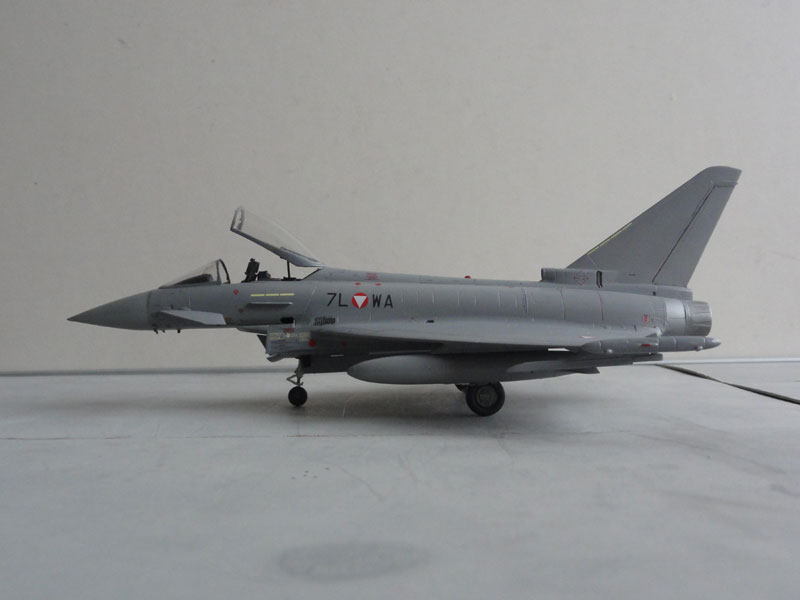
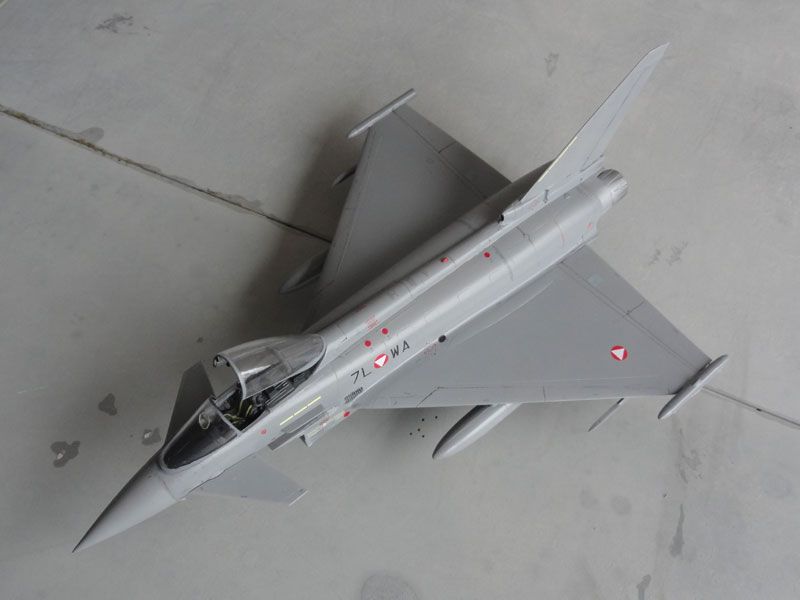

and set in a scenery...

A very nice 1/72 Eurofighter EF2000
is now in the collection besides the much larger 1/32
Revell Typhoon..< READ MORE.
On to next [ Page 2... ]
Back to 1/72 Models
References:
Books and magazines:
Flight International, Supplement, 16-22 June 1999, Reed publishing;
Eurofighter profile, Scale Aircraft Modelling, February 2007;
Eurofighter Typhoon Special, Special, Air International, Key publishing U.K.;
Air International, Volume 85 nr. 5 , November 2013 (with Typhoon special);
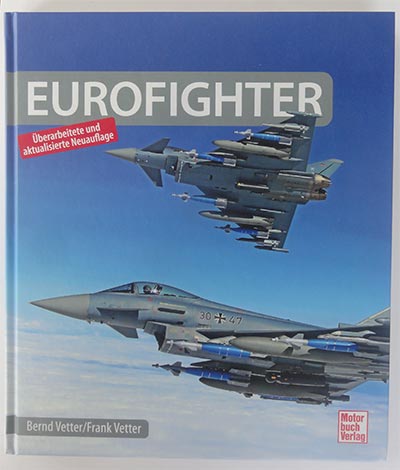
Eurofighter, Motor buch Verlag, Bernd und Frank Vetter, DE (in German), 2023
--------------Internet:
http://www.eurofighter.com/ , official site
IPMS NL Eurofighter walk around ;
Read "why Austria selected the EF2000..."
A discussion on Britmodeller Forum about the Typhoon.. look here...
(c) Copyright "designer"/ All rights reserved. Your comments are welcomed by webmaster
Created March 17, 2014
